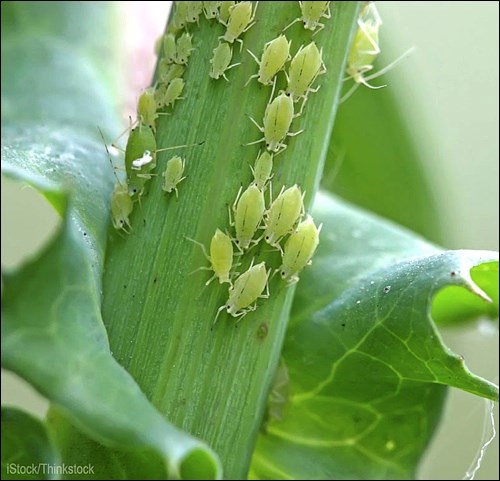It would not be fall without aphids in the garden, I think. Often we don’t notice the aphid itself but do notice the sap-like substance under the infected trees. This is not sap but “honeydew,” which is effectively aphid droppings. When there are heavy infestations of aphids, large amounts of “honeydew” will collect on the leaves, sidewalks and cars that happen to be located under the infected trees.
Aphids are soft-bodied insects that range in size from two to three millimetres in length, are generally pear shaped and come in many colours. They may or may not have wings. They feed by piercing the plant tissue and sucking out the juices of the plant. They prefer to dine on new growth that is succulent and tender like shoots, buds and the underside of leaves. As they eat, they excrete honeydew.
As with many pest problems, aphid control begins with good cultural practices. If your trees and shrubs are in good health and receive adequate moisture they can likely withstand most aphid infestations. In the fall, clean up plant debris as over wintering eggs are generally laid in the crevices of plant material. By doing a good fall cleanup numbers can be reduced.
When combating any pest problem, it is also important to understand the lifecycle of a pest. There are many different species of aphids, each having its own life cycle, however there are some features that are similar with all species. One of the most common features of aphids is that they are incredibly prolific. Wingless adult females can produce up to 50 to 100 offspring. Even more amazing is that within about a week the newly born aphid becomes a reproducing adult that can then produce up to five offspring per day for up to 30 days. What is even more amazing is that with most species of aphids reproduction is accomplished without the help of male aphids in a process called parthenogenesis. When female aphids reproduce parthenogenetically, instead of laying eggs they give birth directly to smaller versions of themselves.
The average life cycle of an aphid begins in the spring when the over wintered egg hatches. This produces a wingless female aphid that soon parthenogenetically produces more wingless females. Their individual lifespan is short but generations of wingless females will survive one another until hot weather comes or the plant they are living on dies. At this time, some of the females will grow wings and fly off. Typically, late in the year when winter is approaching, some aphids will develop into both males and females. Sexual reproduction takes place and the females will lay fertilized eggs on the chosen host plant. Next spring, females will hatch from the eggs and the cycle continues.
Aphids are preyed on by a wide range of natural predators, including ladybird beetles, lacewing flies and syrphid flies. However, in some cases the aphids are present in much higher numbers than their predators. When this happens it is a good idea to exercise control measures. The least toxic alternative always takes more work. You can spray the infected tree frequently with water at high pressure. This will wash away some aphids and kill others with the impact of the water. Insecticides such as insecticidal soap and pyrethrums are a less toxic “chemical” control followed by Ambush as the next least toxic alternative for mammalian species. Malathion and other wide spectrum insecticides will also provide control. Please always follow the specific product instructions and use proper safety precautions as specified on the product label.
— Hanbidge is a horticulturist with the Saskatoon School of Horticulture and can be reached at 306-931-GROW(4769); by email at growyourfuture@gmail.com or check out our website at saskhort.com.



